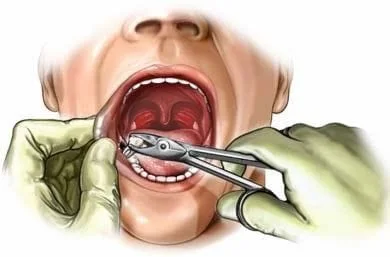Dental Extraction is a removal of a tooth from the mouth. It is performed for a wide variety of reasons. Tooth decay – If the decay is severely advanced and the nerves and blood vessels in the tooth have been infected, and are unsuitable for root canal treatment.
Your dentist will examine your tooth and explain the reasons why your tooth needs to be extracted, an x-ray will be taken to help plan the best way to remove the tooth and to see if an abscess is present.
If an abscess is present your dentist will give you a course of antibiotics before your tooth is extracted.
Your dentist will ask you about your medical history. You must list every medication you are taking even if you have purchased it from over the counter, as some medications can complicate an extraction
Tell your dentist if you are anxious about the procedure as sedation is available. If your dentist does not carry out sedation he will refer you to a practice that does.
How the extraction is carried out
There are two types of extraction
1/ A simple extraction is performed when the tooth can easily be seen in the mouth. The dentist will give you a local anesthetic to numb the area around the tooth. When the anesthetic has taken affect and the area around the tooth is numb the dentist will grasp the tooth using a pair of forceps, you will feel pressure but NO pain. The dentist will move the forceps back and forth to loosen the tooth in order to extract the tooth.
A local anesthetic will be administered to numb the area before a small incision is made in the gum. The gum is pulled back to expose the whole of the tooth or the root. The dentist then uses the same procedure as a simple extraction to remove the tooth, in some cases the tooth or root may have to be cut into pieces to be removed.
3/ When the tooth has been removed a swab will be placed at the extraction site and you will be asked to bite on this until the bleeding has stopped and a blood clot has formed.
Extraction After care
After the extraction a blood clot will form in the socket were the tooth used to be, this is NOT to be disturbed by vigorous rinsing or poking the site with your tongue or finger as it is a very important part of the healing process.
If the socket does start to bleed after you have left the dental practice, place a clean tissue or handkerchief over the extraction site and apply pressure by biting down, the bleeding will normally stop within a few minutes. Again do NOT disturb the blood clot. If the bleeding does persist please contact your dentist for further advice.
Your mouth will still be numb for an hour or so after the local anesthetic, please take care not to bite your cheek or tongue or burn your mouth when drinking hot liquids.
Avoid Smoking and Alcohol for 48 hours as these can have an effect on the healing process
You may be in discomfort after the anesthetic has worn off, take a household painkiller (headache tablet) following the manufacture's instructions. Do NOT take Aspirin as this may cause the socket to bleed.

